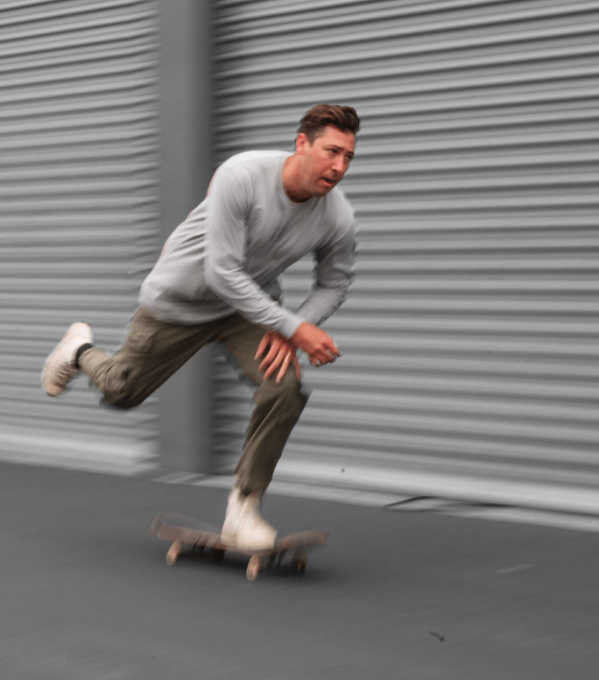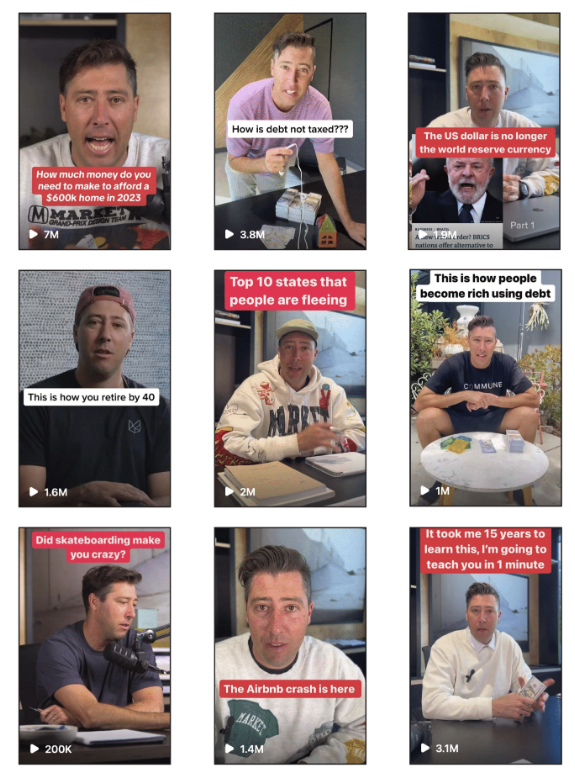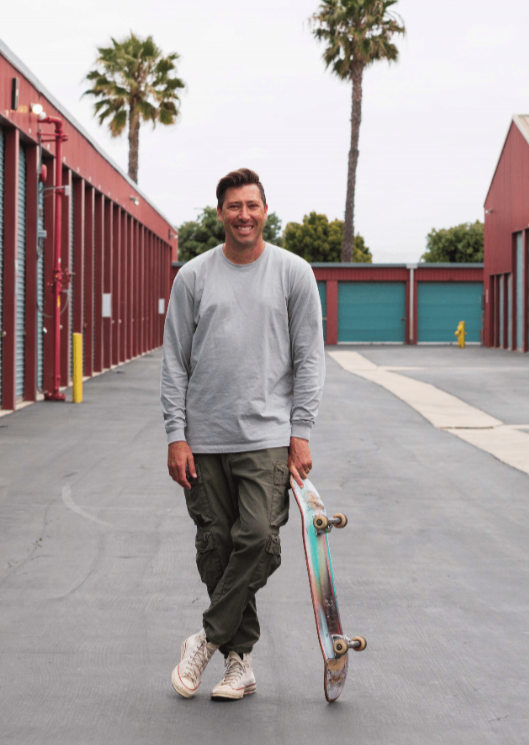Gleaming the Cube: Mikey Taylor's New Grind
In the 1989 film “Gleaming The Cube,” Brain Kelly, a 16-year-old skateboarder played by Christian Slater, defines gleaming the cube as “pushing your limits to the edge.” Perhaps no one has a better grasp of that obscure phrase’s meaning than Mikey Taylor, president and managing principal of California-based Commune Capital, a private equity real estate investment fund. He has been grinding (figuratively and literally) to outdo his objectives since he started skateboarding when he was 13 years old.
"There was a part of skateboarding that really changed the way I looked at the world,” says Taylor. "I never looked at a handrail to be used as anything other than the means to help you walk down or up stairs. When I saw somebody skate on a handrail, everything changed.”
Pastime To Prime Time
Seeing that handrail grind spurred Taylor to get his own skateboard. He skated around his hometown of Thousand Oaks, Calif., a suburb of Los Angeles, and practiced new moves with his friends for fun, all the while blissfully unaware that his board and the sick skills he was developing would eventually flip him into fame.
After approximately four years of pushing himself past his fears to master impressive tricks, Taylor wanted to obtain a sponsor like several of his skateboarding buddies. He gathered contact information for their various sponsors and scoured skateboarding-related advertisements for mailing addresses, then mailed VHS tapes of his best moves to about 20 companies. Taylor could have given up when he didn't receive a single phone call from any of those labels, but determination led him to create an even better reel. He sent out the new video and received three calls.
Taylor landed his first sponsorship deal with Duffs Shoes when he was a junior in high school and began making approximately $800 a month as an amateur skater. He turned pro at 19, earning a six-figure salary by the time he was 24.
“I had no idea it would be a career,” says Taylor. “My original plan was to skate for maybe a few years and then go back to college. And then at that point, skateboarding just exploded.”
Instead of attending law school, he skated until into his early 30s—longer than he expected. As a professional skater he traveled to Spain, China, Japan, and South America to compete in The X Games, ESPN’s extreme sports competition. Throughout his career, he held lucrative sponsorship contracts with DC Shoe Co., GoPro Cameras, and Alien Workshop; he also had over 100 signature skateboard decks and seven pro-model shoes.

Path To Financial Freedom
Through perseverance and intense practice, often pushing himself to exhaustion to conquer his craft, Taylor became one of the most recognizable pro skateboarders on the planet. But the most significant, life-changing technique he learned as a skater was how to make his six-figure salary work for him.
When he decided to pursue a career as a professional skateboarder in lieu of a secondary education, Taylor’s parents weren’t exactly thrilled. Because he would be forgoing a degree, and no one knew how long his pro-skating career would last, they encouraged him to speak with a financial advisor for investment strategies that could enable him to have a fruitful future after retiring from the sport.
“One hundred grand as a professional skateboarder doesn’t feel like one hundred grand in a more conventional career because our careers are so short,” he says. “Maybe by 30 it’s over.”
With expert guidance from Randal Sanada, a family friend and financial advisor, who’s “like a big brother” to Taylor, he managed to avoid bad debt, build credit, control expenses, save money, and make astute investments. “He taught me how to budget; he taught me about paying myself first, and then what to invest in,” Taylor says. “He taught me how to look at an investment through the lens of risk and return.”
Before he was of voting age, and while many other pro skaters his age were gambling with their earnings, Taylor was investing in the stock market and bonds. And in 2005, per Sanada’s suggestion, he invested in real estate.
Taylor wasn’t well-versed in real estate at the time, but he was able to learn what he needed to know from Sanada and his brother, Jerry, who ran RESOP, LLC, a private equity firm with self-storage facilities in its real estate portfolio, and now serves as the CFO and co-president of Commune Capital. His first investment into self-storage was $40,000 into RESOP in 2014, followed by another investment in 2015 of $340,000.
“The first few things I learned was building storage is cheaper than multifamily,” says Taylor. “That price increase isn’t as much of a pain point as other assets. It takes longer to stabilize, and most cities push back on repurposing assets into storage.”
When quarterly dividends from his real estate investments began rolling in, Taylor was hooked. “I became hellbent on the idea of getting to financial freedom through real estate investing,” he says.
To receive higher returns, he curbed his spending and ramped up his investments. Taylor invested about four-fifths of his skateboarding salary into real estate. “I was probably living off $20,000 of it and then just putting as much as I could after taxes into investments.”
In addition to real estate investments, Taylor and two partners utilized investor fundraising to start a brewing company in 2012. They sold Saint Archer Brewing Co. to MillerCoors three years later; at the time of the sale, it was valued at more than $35 million.
“I’ve always had the biggest wins when I’ve invested in myself,” he says. “My first business, Saint Archer, did very well. We were able to 12-times our investors’ money in three years. That was a pretty awesome win!”
He used his share of the profit to make more real estate investments and launch Commune Capital. “We went through a merger in 2021 with Commune and Sanada’s two companies, ABLP [Asset Backed Lending Portfolio] and RESOP [Real Estate Special Opportunity Portfolio]. I had made passive investments into both of those portfolios,” Taylor says, “and when we merged, they became Commune! When I first started investing in RE, I was looking for mostly growth. I wanted to invest in adaptive reuse or redevelopment opportunities. I also wanted assets that performed well during economic downturns. Since I was investing passively, I wanted to trust the operator; they needed to have experience, and I wanted access to the decision makers. I’m still pretty young, so I still have a focus on growth, but we are very heavy in multifamily as well as storage.”

According to Taylor, he started Commune Capital to inspire other pro skaters to invest in their post-skating lives.“I’m convinced that skaters can succeed in anything,” he posted on his personal social media pages shortly after starting Commune Capital and receiving flak for talking about money and business. “Why can’t we? If we’re willing to throw our bodies off a set of stairs for hours just to land a trick once, why can’t we start a business?”
“Business, for the most part, is just a bunch of problems, and it’s your ability to get freaked out by those problems and then solve them over and over and over and over,” says Taylor. “It never gets easier, but there’s a comfort with chaos that came from skateboarding.”
Today, Commune Capital manages more than $200 million of real estate. Investors with a net worth of $1 million or more can invest in (and receive distributions from) its asset-backed lending portfolio that provides loans to commercial real estate owners. Commune Capital’s portfolio includes apartment buildings and seven self-storage facilities that have a combined total of approximately 8,000 units.
“Our current multifamily fund (FUNDV) has a little over 100 units being developed in California,” he says, noting that the total cost is around $50 million. The firm, which is currently building its eighth self-storage location, self-manages one facility in Saticoy, Calif; Life Storage and CubeSmart manage its six other facilities in Connecticut, Illinois, Iowa, Ohio, and Washington.
He favors investing in self-storage because it cash flows well but admits that it has become more difficult to find distressed assets and rezone and repurpose them. “It feels saturated now,” says Taylor, adding that investors and developers must “hustle to look for deals” or “get creative with deals.” Alternatively, residential is undersupplied and multifamily has a “lot of deal flow. Cities love it.”
He goes on to say, “First and foremost, we want a location that has demand for storage. We’re looking at how many other storage units are in a one-, three-, and five-mile radius. We look at overall market occupancy and what rents have done over the past five years. We look at the major employers in the area and want some diversity in industry for them. We want population growth, and we’re looking at the median household income. Our newest storage facility is in Indianapolis. We are adding 1,191 units. We start construction Q1 2024 and should be complete Q4 2024. The purchase price was $7.5 million and total cost $18.9 million.”
Commune Capital currently has 500 investors and 50 percent of its equity capital comes from the firm’s social media followers. His real estate goal for Commune Capital is to reach $1 billion in assets under management (AUM) within five years. To hit that target, he plans to create new verticals, products, and services that fit in with Commune Capital’s existing social media efforts.
Thanks to his drive and numerous real estate investments, Taylor was financially free at 33—roughly 15 years after he first invested in self-storage. And his financial freedom could not have come at a better time. In 2016, about a year after he hit that momentous milestone, he sustained an injury that put his pro skater status up in the air. Taylor tore a ligament in his leg that required surgery; then, his sponsor, DC Shoes, let him go two months post-op. With four more months till he could return to skating, he had two options: find another sponsor after recovery or quit skating professionally. He chose to heal and focus on his energy on growing his family, business, and social media presence.
Skater Turned Teacher
For Taylor, financial freedom is living comfortably off passive income earned from existing investments. Through various social media platforms, including TikTok, Instagram, YouTube, and Facebook, he discusses financial freedom strategies like FIRE (Financial Independence Retire Early) and teaches financial literacy to followers and fans via original content that he creates daily.
“On some of these platforms, I have a bigger following than I had when I was a pro skateboarder,” he says, adding that he aspires to grow his audience base and eventually have 100 percent of Commune Capital’s equity capital coming from social media.

Taylor goes on to say that he never thought he’d be a teacher, but he greatly enjoys the challenge of simplifying and putting a creative spin on complex financial concepts. He’s also enthusiastic about having the opportunity to “give back” knowledge that helped him succeed to a larger, more receptive audience than his fellow skaters.
Taylor recalls encouraging them to invest in a new self-storage offering that popped up after his initial investment and some of their “eyes glazed over” when he discussed the specifics of investing to bring in passive income and eventually exit out of skating. “They thought it was boring. I was selling storage first, and that’s not ‘sexy,’” he says, “but financial freedom is!” However, his message did resonate with two other pro skaters, Paul Rodriguez and Sean Malto, who followed his advice and invested.
He’s since realized that their perplexity was related to the financial aspect of his proposal, not self-storage, which is why Taylor began teaching financial literacy through social media. He also believes people should be learning about how to invest in money long before they are working adults. As a father of four, Taylor is interested in getting several other educational projects off the ground: a board game and curriculum materials for each grade level—all of which would help children learn about money and understand financial concepts they may use later in life.
Taylor’s also extending his knowledge and expertise to his hometown of Thousand Oaks, where he still lives with his wife, Jen, who was his childhood neighbor, and their four children. With visions for making the town a more happening place for millennials, he ran for city council, was elected last November, and started in January.
“When I looked around at where I thought my skillset could add value to our community, city council was the one that I thought was the best fit,” says Taylor. The position has enabled him to work with the planning commission, to which he’s offered advice about a proposed self-storage facility. “It’s good to see the other side of development,” he says about zoning, approvals, and urban planning. “I have a better understanding of the process.”

Still Grinding
Although he’s achieved financial freedom, Taylor’s still grinding, just not on handrails as much. Supporting his family, growing his investment firm, creating content for his social media accounts, and serving on his city council have taken precedence over his passion, but he still shreds when time permits. And if his extraordinary past and present are indicative of his future, Taylor may never stop gleaming the cube!
–
Erica Shatzer is the editor of Modern Storage Media.
More Content
Popular Posts
The self storage industry is in a precarious...
Joe Shoen, CEO of U-Haul, has had enough.
Like its name implies, Surprise, Ariz., a...
Joe Shoen has had enough.
In a record-breaking deal finalized May 12,...
Senate Bill 709 (SB709) has many in the...
Donald Trump has just reclaimed the White...
The question of “abandonment” of stored...
Self-storage operators wear a lot of hats....
In 1992, Clinton strategist James Carville...
Recent Posts
When Neville Kennard left for a work trip to...
Self-storage software is no longer...
The self-storage industry continues to...
Fires in California. Tornadoes in Kansas....
From policy pivots in Ottawa to tariff...
Self-storage operators have struggled to...
Their signature red coats may draw attention...
Nailing down Josh and Melissa Huff for an...



















